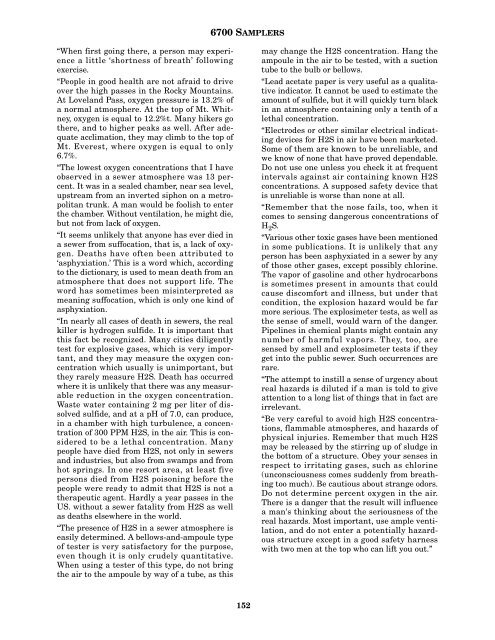6700 Portable Sampler User Manual - Isco
6700 Portable Sampler User Manual - Isco
6700 Portable Sampler User Manual - Isco
Create successful ePaper yourself
Turn your PDF publications into a flip-book with our unique Google optimized e-Paper software.
“When first going there, a person may experience<br />
a little ‘shortness of breath’ following<br />
exercise.<br />
“People in good health are not afraid to drive<br />
over the high passes in the Rocky Mountains.<br />
At Loveland Pass, oxygen pressure is 13.2% of<br />
a normal atmosphere. At the top of Mt. Whitney,<br />
oxygen is equal to 12.2%t. Many hikers go<br />
there, and to higher peaks as well. After adequate<br />
acclimation, they may climb to the top of<br />
Mt. Everest, where oxygen is equal to only<br />
6.7%.<br />
“The lowest oxygen concentrations that I have<br />
observed in a sewer atmosphere was 13 percent.<br />
It was in a sealed chamber, near sea level,<br />
upstream from an inverted siphon on a metropolitan<br />
trunk. A man would be foolish to enter<br />
the chamber. Without ventilation, he might die,<br />
but not from lack of oxygen.<br />
“It seems unlikely that anyone has ever died in<br />
a sewer from suffocation, that is, a lack of oxygen.<br />
Deaths have often been attributed to<br />
‘asphyxiation.’Thisisawordwhich,according<br />
to the dictionary, is used to mean death from an<br />
atmosphere that does not support life. The<br />
word has sometimes been misinterpreted as<br />
meaning suffocation, which is only one kind of<br />
asphyxiation.<br />
“In nearly all cases of death in sewers, the real<br />
killer is hydrogen sulfide. It is important that<br />
this fact be recognized. Many cities diligently<br />
test for explosive gases, which is very important,<br />
and they may measure the oxygen concentration<br />
which usually is unimportant, but<br />
they rarely measure H2S. Death has occurred<br />
where it is unlikely that there was any measurable<br />
reduction in the oxygen concentration.<br />
Waste water containing 2 mg per liter of dissolved<br />
sulfide, and at a pH of 7.0, can produce,<br />
in a chamber with high turbulence, a concentration<br />
of 300 PPM H2S, in the air. This is considered<br />
to be a lethal concentration. Many<br />
people have died from H2S, not only in sewers<br />
and industries, but also from swamps and from<br />
hot springs. In one resort area, at least five<br />
persons died from H2S poisoning before the<br />
people were ready to admit that H2S is not a<br />
therapeutic agent. Hardly a year passes in the<br />
US. without a sewer fatality from H2S as well<br />
as deaths elsewhere in the world.<br />
“The presence of H2S in a sewer atmosphere is<br />
easily determined. A bellows-and-ampoule type<br />
of tester is very satisfactory for the purpose,<br />
even though it is only crudely quantitative.<br />
When using a tester of this type, do not bring<br />
the air to the ampoule by way of a tube, as this<br />
<strong>6700</strong> SAMPLERS<br />
152<br />
may change the H2S concentration. Hang the<br />
ampoule in the air to be tested, with a suction<br />
tube to the bulb or bellows.<br />
“Lead acetate paper is very useful as a qualitativeindicator.Itcannotbeusedtoestimatethe<br />
amount of sulfide, but it will quickly turn black<br />
in an atmosphere containing only a tenth of a<br />
lethal concentration.<br />
“Electrodes or other similar electrical indicating<br />
devices for H2S in air have been marketed.<br />
Some of them are known to be unreliable, and<br />
we know of none that have proved dependable.<br />
Donotuseoneunlessyoucheckitatfrequent<br />
intervals against air containing known H2S<br />
concentrations. A supposed safety device that<br />
is unreliable is worse than none at all.<br />
“Remember that the nose fails, too, when it<br />
comes to sensing dangerous concentrations of<br />
H2S. “Various other toxic gases have been mentioned<br />
in some publications. It is unlikely that any<br />
person has been asphyxiated in a sewer by any<br />
of those other gases, except possibly chlorine.<br />
The vapor of gasoline and other hydrocarbons<br />
is sometimes present in amounts that could<br />
cause discomfort and illness, but under that<br />
condition, the explosion hazard would be far<br />
more serious. The explosimeter tests, as well as<br />
the sense of smell, would warn of the danger.<br />
Pipelines in chemical plants might contain any<br />
number of harmful vapors. They, too, are<br />
sensed by smell and explosimeter tests if they<br />
get into the public sewer. Such occurrences are<br />
rare.<br />
“The attempt to instill a sense of urgency about<br />
realhazardsisdilutedifamanistoldtogive<br />
attention to a long list of things that in fact are<br />
irrelevant.<br />
“Be very careful to avoid high H2S concentrations,<br />
flammable atmospheres, and hazards of<br />
physical injuries. Remember that much H2S<br />
may be released by the stirring up of sludge in<br />
the bottom of a structure. Obey your senses in<br />
respect to irritating gases, such as chlorine<br />
(unconsciousness comes suddenly from breathing<br />
too much). Be cautious about strange odors.<br />
Do not determine percent oxygen in the air.<br />
There is a danger that the result will influence<br />
a man's thinking about the seriousness of the<br />
real hazards. Most important, use ample ventilation,<br />
and do not enter a potentially hazardous<br />
structure except in a good safety harness<br />
withtwomenatthetopwhocanliftyouout.”

















